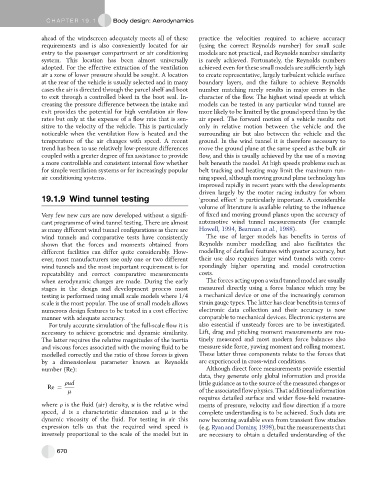Page 660 - Automotive Engineering Powertrain Chassis System and Vehicle Body
P. 660
CHAP TER 1 9. 1 Body design: Aerodynamics
ahead of the windscreen adequately meets all of these practice the velocities required to achieve accuracy
requirements and is also conveniently located for air (using the correct Reynolds number) for small scale
entry to the passenger compartment or air conditioning models are not practical, and Reynolds number similarity
system. This location has been almost universally is rarely achieved. Fortunately, the Reynolds numbers
adopted. For the effective extraction of the ventilation achieved even for these small models are sufficiently high
air a zone of lower pressure should be sought. A location to create representative, largely turbulent vehicle surface
at the rear of the vehicle is usually selected and in many boundary layers, and the failure to achieve Reynolds
cases the air is directed through the parcel shelf and boot number matching rarely results in major errors in the
to exit through a controlled bleed in the boot seal. In- character of the flow. The highest wind speeds at which
creasing the pressure difference between the intake and models can be tested in any particular wind tunnel are
exit provides the potential for high ventilation air flow more likely to be limited by the ground speed than by the
rates but only at the expense of a flow rate that is sen- air speed. The forward motion of a vehicle results not
sitive to the velocity of the vehicle. This is particularly only in relative motion between the vehicle and the
noticeable when the ventilation flow is heated and the surrounding air but also between the vehicle and the
temperature of the air changes with speed. A recent ground. In the wind tunnel it is therefore necessary to
trend has been to use relatively low-pressure differences move the ground plane at the same speed as the bulk air
coupled with a greater degree of fan assistance to provide flow, and this is usually achieved by the use of a moving
a more controllable and consistent internal flow whether belt beneath the model. At high speeds problems such as
for simple ventilation systems or for increasingly popular belt tracking and heating may limit the maximum run-
air conditioning systems. ning speed, although moving ground plane technology has
improved rapidly in recent years with the developments
driven largely by the motor racing industry for whom
19.1.9 Wind tunnel testing ‘ground effect’ is particularly important. A considerable
volume of literature is available relating to the influence
Very few new cars are now developed without a signifi- of fixed and moving ground planes upon the accuracy of
cant programme of wind tunnel testing. There are almost automotive wind tunnel measurements (for example
as many different wind tunnel configurations as there are Howell, 1994, Bearman et al., 1988).
wind tunnels and comparative tests have consistently The use of larger models has benefits in terms of
shown that the forces and moments obtained from Reynolds number modelling and also facilitates the
different facilities can differ quite considerably. How- modelling of detailed features with greater accuracy, but
ever, most manufacturers use only one or two different their use also requires larger wind tunnels with corre-
wind tunnels and the most important requirement is for spondingly higher operating and model construction
repeatability and correct comparative measurements costs.
when aerodynamic changes are made. During the early The forces acting upon a wind tunnel model are usually
stages in the design and development process most measured directly using a force balance which may be
testing is performed using small scale models where 1/4 a mechanical device or one of the increasingly common
scale is the most popular. The use of small models allows strain gauge types. The latter has clear benefits in terms of
numerous design features to be tested in a cost effective electronic data collection and their accuracy is now
manner with adequate accuracy. comparable to mechanical devices. Electronic systems are
For truly accurate simulation of the full-scale flow it is also essential if unsteady forces are to be investigated.
necessary to achieve geometric and dynamic similarity. Lift, drag and pitching moment measurements are rou-
The latter requires the relative magnitudes of the inertia tinely measured and most modern force balances also
and viscous forces associated with the moving fluid to be measure side force, yawing moment and rolling moment.
modelled correctly and the ratio of those forces is given These latter three components relate to the forces that
by a dimensionless parameter known as Reynolds are experienced in cross-wind conditions.
number (Re): Although direct force measurements provide essential
data, they generate only global information and provide
rud little guidance as to the source of the measured changes or
Re ¼
m of the associated flow physics. That additional information
requires detailed surface and wider flow-field measure-
where r is the fluid (air) density, u is the relative wind ments of pressure, velocity and flow direction if a more
speed, d is a characteristic dimension and m is the complete understanding is to be achieved. Such data are
dynamic viscosity of the fluid. For testing in air this now becoming available even from transient flow studies
expression tells us that the required wind speed is (e.g. Ryan and Dominy, 1998), but the measurements that
inversely proportional to the scale of the model but in are necessary to obtain a detailed understanding of the
670

